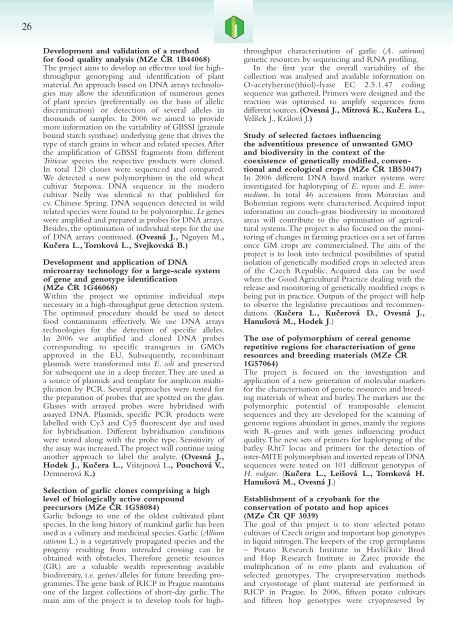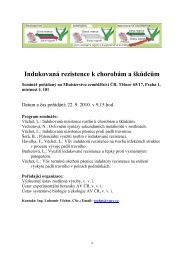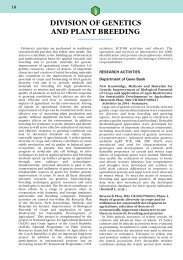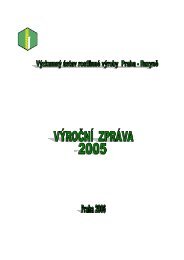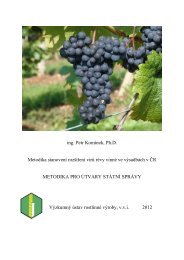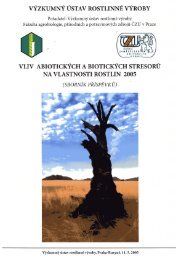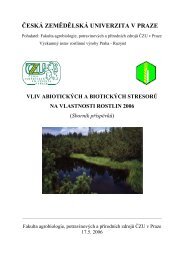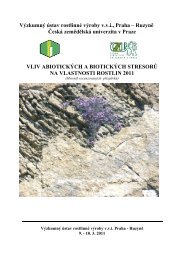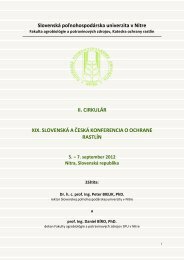00 ZLOM VURV 06 v roce 07
00 ZLOM VURV 06 v roce 07
00 ZLOM VURV 06 v roce 07
Create successful ePaper yourself
Turn your PDF publications into a flip-book with our unique Google optimized e-Paper software.
26<br />
Development and validation of a method<br />
for food quality analysis (MZe âR 1B44<strong>06</strong>8)<br />
The project aims to develop an effective tool for highthroughput<br />
genotyping and identification of plant<br />
material.An approach based on DNA arrays technologies<br />
may allow the identification of numerous genes<br />
of plant species (preferentially on the basis of allelic<br />
discrimination) or detection of several alleles in<br />
thousands of samples. In 2<strong>00</strong>6 we aimed to provide<br />
more information on the variability of GBSSI (granule<br />
bound starch synthase) underlying gene that drives the<br />
type of starch grains in wheat and related species.After<br />
the amplification of GBSSI fragments from different<br />
Triticeae species the respective products were cloned.<br />
In total 120 clones were sequenced and compared.<br />
We detected a new polymorphism in the old wheat<br />
cultivar Stepowa. DNA sequence in the modern<br />
cultivar Nelly was identical to that published for<br />
cv. Chinese Spring. DNA sequences detected in wild<br />
related species were found to be polymorphic. Lr genes<br />
were amplified and prepared as probes for DNA arrays.<br />
Besides, the optimisation of individual steps for the use<br />
of DNA arrays continued. (Ovesná J., Nguyen M.,<br />
Kuãera L., Tomková L., Svejkovská B.)<br />
Development and application of DNA<br />
microarray technology for a large-scale system<br />
of gene and genotype identification<br />
(MZe âR 1G46<strong>06</strong>8)<br />
Within the project we optimise individual steps<br />
necessary in a high-throughput gene detection system.<br />
The optimised p<strong>roce</strong>dure should be used to detect<br />
food contaminants effectively. We use DNA arrays<br />
technologies for the detection of specific alleles.<br />
In 2<strong>00</strong>6 we amplified and cloned DNA probes<br />
corresponding to specific transgenes in GMOs<br />
approved in the EU. Subsequently, recombinant<br />
plasmids were transformed into E. coli and preserved<br />
for subsequent use in a deep freezer. They are used as<br />
a source of plasmids and template for amplicon multiplication<br />
by PCR. Several approaches were tested for<br />
the preparation of probes that are spotted on the glass.<br />
Glasses with arrayed probes were hybridised with<br />
assayed DNA. Plasmids, specific PCR products were<br />
labelled with Cy3 and Cy5 fluorescent dye and used<br />
for hybridisation. Different hybridisation conditions<br />
were tested along with the probe type. Sensitivity of<br />
the assay was increased.The project will continue using<br />
another approach to label the analyte. (Ovesná J.,<br />
Hodek J., Kuãera L., Vi‰tejnová L., Pouchová V.,<br />
Demnerová K.)<br />
Selection of garlic clones comprising a high<br />
level of biologically active compound<br />
precursors (MZe âR 1G58084)<br />
Garlic belongs to one of the oldest cultivated plant<br />
species. In the long history of mankind garlic has been<br />
used as a culinary and medicinal species. Garlic (Allium<br />
sativum L.) is a vegetatively propagated species and the<br />
progeny resulting from intended crossing can be<br />
obtained with obstacles. Therefore genetic resources<br />
(GR) are a valuable wealth representing available<br />
biodiversity, i.e. genes/alleles for future breeding programmes.The<br />
gene bank of RICP in Prague maintains<br />
one of the largest collections of short-day garlic. The<br />
main aim of the project is to develop tools for highthroughput<br />
characterisation of garlic (A. sativum)<br />
genetic resources by sequencing and RNA profiling.<br />
In the first year the overall variability of the<br />
collection was analysed and available information on<br />
O-acetylserine(thiol)-lyase EC 2.5.1.47 coding<br />
sequence was gathered. Primers were designed and the<br />
reaction was optimised to amplify sequences from<br />
different sources. (Ovesná J., Mitrová K., Kuãera L.,<br />
Velí‰ek J., Králová J.)<br />
Study of selected factors influencing<br />
the adventitious presence of unwanted GMO<br />
and biodiversity in the context of the<br />
coexistence of genetically modified, conventional<br />
and ecological crops (MZe âR 1B53047)<br />
In 2<strong>00</strong>6 different DNA based marker systems were<br />
investigated for haplotyping of E. repens and E. intermedium.<br />
In total 46 accessions from Moravian and<br />
Bohemian regions were characterised. Acquired input<br />
information on couch-grass biodiversity in monitored<br />
areas will contribute to the optimisation of agricultural<br />
systems.The project is also focused on the monitoring<br />
of changes in farming practices on a set of farms<br />
once GM crops are commercialised. The aim of the<br />
project is to look into technical possibilities of spatial<br />
isolation of genetically modified crops in selected areas<br />
of the Czech Republic. Acquired data can be used<br />
when the Good Agricultural Practice dealing with the<br />
release and monitoring of genetically modified crops is<br />
being put in practice. Outputs of the project will help<br />
to observe the legislative precautions and recommendations.<br />
(Kuãera L., Kuãerová D., Ovesná J.,<br />
Hanu‰ová M., Hodek J.)<br />
The use of polymorphism of cereal genome<br />
repetitive regions for characterisation of gene<br />
resources and breeding materials (MZe âR<br />
1G57<strong>06</strong>4)<br />
The project is focused on the investigation and<br />
application of a new generation of molecular markers<br />
for the characterisation of genetic resources and breeding<br />
materials of wheat and barley.The markers use the<br />
polymorphic potential of transposable element<br />
sequences and they are developed for the scanning of<br />
genome regions abundant in genes, mainly the regions<br />
with R-genes and with genes influencing product<br />
quality.The new sets of primers for haplotyping of the<br />
barley Rht7 locus and primers for the detection of<br />
inter-MITE polymorphism and inverted repeats of DNA<br />
sequences were tested on 101 different genotypes of<br />
H. vulgare. (Kuãera L., Lei‰ová L., Tomková H.<br />
Hanu‰ová M., Ovesná J.)<br />
Establishment of a cryobank for the<br />
conservation of potato and hop apices<br />
(MZe âR QF 3039)<br />
The goal of this project is to store selected potato<br />
cultivars of Czech origin and important hop genotypes<br />
in liquid nitrogen.The keepers of the crop germplasms<br />
– Potato Research Institute in HavlíãkÛv Brod<br />
and Hop Research Institute in Îatec provide the<br />
multiplication of in vitro plants and evaluation of<br />
selected genotypes. The cryopreservation methods<br />
and cryostorage of plant material are performed in<br />
RICP in Prague. In 2<strong>00</strong>6, fifteen potato cultivars<br />
and fifteen hop genotypes were cryopreseved by


